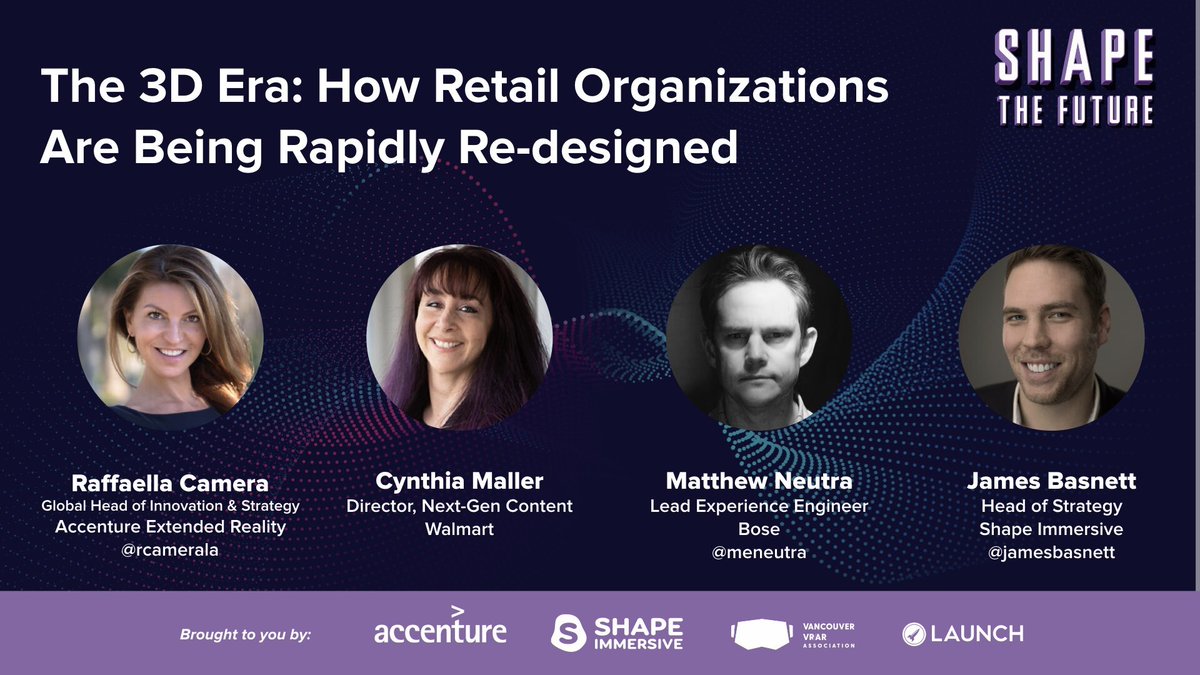
Advertising continues to be a bright spot in AR’s otherwise-challenged early days. Brand spending on AR ads is on track reach $1.41 billion this year according to ARtillery Intelligence estimates, making this one of the highest-performing subsectors of the AR universe.
But the opportunity goes beyond advertising. AR will influence commerce through brands’ and retailers’ self-distributed apps for eCommerce and in-aisle retail experiences. This involves an expanding value chain from 3D product models to experience creation to distribution to analytics.
To make sense of it all, Shape Immersive ran a series of virtual events over the past few months. The takeaways were robust enough to devote a multi-part run of our XR Talks series, continuing here in part 4 with an AR expert panel including Accenture XR, Bose and Walmart (video below).

Storytelling Medium
One way to look at AR is as another storytelling medium for consumer brands, says Bose’ Matthew Neutra. And fortunately, AR has natural capabilities to tell product stories with greater dimension — literally. This can be harnessed to the greatest effect for products that require education.
One example is Bose Frames. The now-defunct product (though representing the promising field of audio AR) stood within a new hardware category. Bose deployed AR for the requisite consumer education process, including immersive product try-ons and rear-facing AR visualization.
When doing this, take advantage of the unique things that only AR can do, says Neutra. For example, Bose Frames’ AR demonstration let consumers spin the glasses around and blow out its components to get a sense of the technical fidelity… which you can’t do in real life.
These are all exciting possibilities for brands, but one challenge is that most consumers aren’t yet asking for AR. On the other hand, COVID-era lockdowns have accelerated digital transformation. Many consumers are discovering AR to bring more lifelike dimension to eCommerce.
This has accelerated AR’s cultural acclimation, which could then transition into the technology’s post-COVID use in the “touchless” era of physical retail, as we’ve examined. Walmart’s Cynthia Maller likens this to 9-11, after which chat and messaging went from trite social tools to essential.

Maximum Mileage
Beyond consumer adoption hurdles, there’s inertia on the brand side. This comes down to several organizational issues including everything from product strategy to culture. Starting with strategic factors, it’s about prioritizing resources towards the greatest potential impact.
For example, considering the resources required to create digital twins, there doesn’t necessarily need to be AR-ready 3D models for every product that a brand carries. Maller gives the example of Walmart’s grocery department: investment in 3D models for chicken breasts isn’t optimal.
Here, it’s all about visualizing the end consumer experience, then working backward from there — a simplified way of describing the complex and methodical science that Neutra practices at Bose. Maller likewise asserts that a brand always has to be its own customer to maintain perspective.
Accenture XR’s Raffaella Camera asserts that once these decisions are made, it’s advisable to get maximum mileage out of 3D models to maximize their value. As we’ve examined, this is all about amortizing the sunk costs of 3D model creation by using them across several functions.
Camera lists a few of these functions including internal product research, more efficient product prototyping, and immersive marketing. There’s also the field of virtual product merchandising, which Accenture XR executed for Kellogg’s to test and validate optimal retail shelf placement.
Social Engineering
On to organizational factors, there’s the matter of how these technologies are implemented and how workflows are optimized. For example, will we see org charts altered, or at least new job titles — a prospective Chief 3D Officer? Will skill sets evolve for product managers and other roles?
For example, There’s currently a long road from CAD model to completed AR experience. The tools need to catch up with the technology, says Neutra. There’s software that’s “approaching usability” but it still requires special skills. What’s needed is the iMovie of AR workflows, he says.
Meanwhile, inertia slows down AR and 3D process evolution within most companies due to risk aversion and vested interests in the status quo. This is always uncomfortable, says Neutra — for the change agents that push new technology, and those who don’t want to be pushed.
His advice: build nimble teams that can work quick, cheap and fail fast. Find an optimal UX through that iterative process and build something tangible. Then map it to business goals. Once you have these elements, you can win over top decision-makers by “showing rather than telling.”
“This can move the needle inside of organizations because it’s social engineering at that point, not technical engineering,” said Neutra. “People know how to make AR…but what they don’t know how to do is to change the minds of people who are writing checks to do that work.”
See the full video below.

